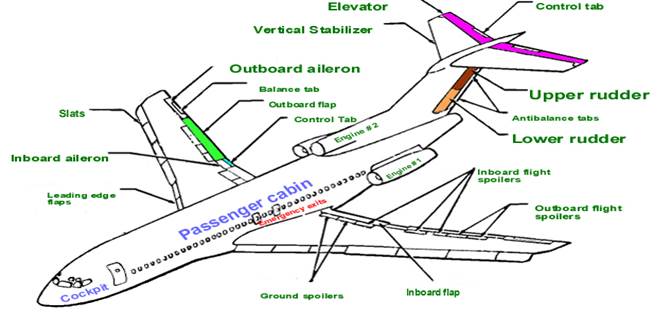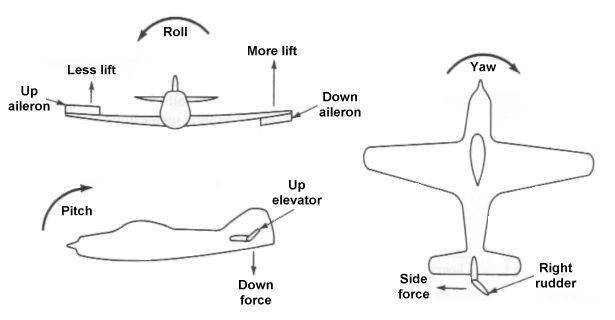Look through each part of the text and say what it is about. Entitle each paragraph.
Match the words in A to the words with the similar meaning in B.
A B
| 1. complicated | a) surroundings |
| 2. reverse | b) additional |
| 3. auxiliary | c) complex |
| 4. distribution | d) location |
| 5. to change | e) to alter |
| 6. purpose | f) to write down on a tape |
| 7. to record | g) dealing out |
| 8. variables | h)changeable quantities |
| 9. whereabouts | i) to hold something up |
| 10. aids | j) facilities |
| 11. to contain | k) with the purpose of |
| 12. to discover | l) to consist of, comprise |
| 13. in order to | m) action of changing direction |
| 14. deflection | n) to join or fix to smth |
| 15. mainly | o) function |
| 16. to attach | p) chiefly |
| 17. avionics | q) equipment |
| 18. device | r) to detect |
| 19. behaviour | s) aim |
| 20. to support | t) opposite |
| 21. environment | u) aviation electronics |
Match the words in A to the words in B to make collocations. Different variants are possible.
A B
| 1. complicated | a) stabilizer and rudder |
| 2. main | b) controls and instruments |
| 3. direct and reverse | c) stability in flight |
| 4. auxiliary | d) construction |
| 5. fuel | e) stabilizer and elevator |
| 6. secondary | f) thrust |
| 7. to lower | g) storage and distribution |
| 8. fuselage | h) structure |
| 9. to get | i) lifting surfaces |
| 10. flight | j) flight controls |
| 11. vertical | k) normal conditions |
| 12. horizontal | l) landing gear |
| 13. to provide | m) turn |
| 14. to extend | n) upward/downward |
| 15. to execute | o) power unit |
| 16. to deflect | p) slats |
Fill in the gaps with the words from the boxes. Check new words with your teacher or in a dictionary.
Aileron, aisle, aerofoil, fuselage, nacelles, pulls up, rudder, stall, cowling, lowers, trailing edge, wing tips, wing, flaps
1. The _______________ is a metal cover for an aircraft engine.
2. ______________ is the main lifting surface.
3. Wings are attached to the ________________.
4. The ____________ is open space between rows of seats.
5. The _____________ is a part of the fin.
6. Engines are housed in _______________.
7. The ________________ is a surface which is shaped to produce more lift than drag when moved through the air.
8. Ailerons are located at the _______________ close to the________________.
9. The airplane banks when one _______________ is raised, and the other ______________.
10. When the control stick is moved backward, the airplane __________________.
11. The aircraft will ______________ if the flight speed is too low.
12. _________________ are most often used during take off and landing to increase the lift the wing generates at a given speed.
Look through each part of the text and say what it is about. Entitle each paragraph.
__________________________________
The word “aircraft» means any kind of craft or vehicle which air can support and which is able to fly in the air and carry goods, passengers or weapon.
Aeroplanes, helicopters, hot-air balloons, airships and gliders are all aircraft. They are supported by dynamic action of the air upon their aerodynamic surfaces or aerofoils to develop the necessary supporting force.
A modern aircraft is a very complicated construction. All commercial (that is cargo or passenger) and military airplanes consist of two main parts: airframe and power plant. The airframe consists of fuselage, wings, landing gear and empennage or tail unit. The power plant consists of one or several engines.
___________________________________
The fuselage is the main structural body of an airplane and contains the crew and payload, either passengers or cargo.
The cockpit, where the flight crew work, houses flight controls and instruments. The cabin with rows of passenger seats and aisles takes up the larger part of the fuselage.
All the other major components of the aircraft are attached to the fuselage. They are the wing, the engine, the empennage and landing gears.
The wing is the main lifting surface which supports the weight of the aircraft in flight. It produces lift because of its special shape, called an aerofoil. A traditional aerofoil has a rounded leading edge and a sharp trailing edge. The main parts of the wing are: flaps, ailerons, slats, spoilers and airbrakes.
The landing gear (or undercarriage) is a component of the airplane that supports and provides mobility on land or any surface. The main parts of the undercarriage are the main gear, the nose gear, the wheels, the tires, the shock absorbers or struts and the retracting mechanism. In flight the landing gears are retracted into the wing or fuselage structure called the wing bay.
The tail assembly or empennage is the combination of stabilizing and controlling surfaces, located at the rear part of the airplane. It consists of the vertical stabilizer called the fin, the horizontal stabilizer, the rudder and elevators.
The other key component that makes an airplane go is its engine, or engines.
Aircraft use several different kinds of engines, but they can all be classified in two major categories: propeller-driven piston engines which are still common today on light general aviation planes and jet engines used by most modern aircraft now. Many aircraft house the engine(s) within the fuselage itself. Most large planes, however, have their engines mounted in separate pods hanging below the wing or sometimes attached to the fuselage. These pods are called nacelles. The plane also has auxiliary power unit (APU) – a small turbine for alternate power to support aircraft systems on the ground and in flight.
__________________________________
The Flight control surfaces are aerodynamic or mechanical devices which are used by the pilot to control direction, altitude and speed of the airplane.
The three basic control surfaces are the ailerons, the elevators and the rudder. The rudder controls the yawing movement of the airplane around its vertical axis. In this way, the rudder turns the airplane to the left or to the right. This type of motion is called “yaw”. But to do its job efficiently the rudder must be assisted by another flight control, called ailerons. The ailerons are located at the trailing edge close to the wing tips and designed to control the airplane in “roll” by their different movement.
Lowering or raising the ailerons makes the airplane bank to the left or to the right and move around its longitudinal axis. So before executing any turn, the pilot first banks the plane and only then uses pedals to rotate the rudder in the needed direction. To change altitude of flight the pilot uses elevator, which is the control for making the plane climb or dive by raising or lowering the tail.
When the control stick (yoke) is moved forward, the elevators lower, and the plane dives. When the control stick (yoke) is moved backward, the elevators go up, and the airplane pulls up. The plane moves around its lateral axis. This type of motion is called “pitch”.
______________________________
Airplanes have a set of secondary flight control surfaces that may include devices such as flaps, slats, trim tabs, spoilers, and speed brakes. Flaps are usually located along the trailing edge of both the left and right wing, typically inboard of the ailerons and close to the fuselage. Flaps are similar to ailerons in that they affect the amount of lift created by the wings. However, flaps only deflect downward to increase the lift produced by both wings simultaneously. Flaps are most often used during take off and landing to increase the lift the wing generates at a given speed. This effect allows a plane to take off, or land at a slower speed. Flaps on the leading-edge, more often called leading-edge slats, are usually extended from the front of the wing at low speed to change the way the air flows over the wing, thereby increasing lift. Trim tabs may be located on the elevator, rudder and aileron. The purpose of all these tabs is the same. They are used to adjust more precisely the flight path of an airplane. The pilot can set the deflection of the trim tabs that create basic control surfaces deflection automatically.
_______________________________
Aircraft instruments are basically devices for obtaining information about the aircraft and its environment and for presenting that information to the pilot. Their purpose is to detect, measure, record, process and analyze the variables encountered in flying. They are mainly electrical, electronic, navigation or gyroscopic instruments. Modern aircraft are equipped with the computers (Flight management system), which coordinate speed, height or flight level of the aircraft and its whereabouts, also the behavior of all aircraft systems.
____________________________________
The main aircraft systems are Engine Control and Indication Systems; Fuel and Oil Systems; Hydraulic system; Environmental system including Pressurization System, Air-Conditioning System, Equipment Cooling System; Navigation and Avionics systems, Emergency System.
The aircraft’s avionics system comprises electronic communication, navigation and flight control equipment of an aircraft.
Besides there is Fuel System itself apart of engines for the aircraft fuelling, fuel storage and distribution.

 5. Look at the picture, read part 3 of the text and speak about types of aircraft motion around three separate axes.
5. Look at the picture, read part 3 of the text and speak about types of aircraft motion around three separate axes.
